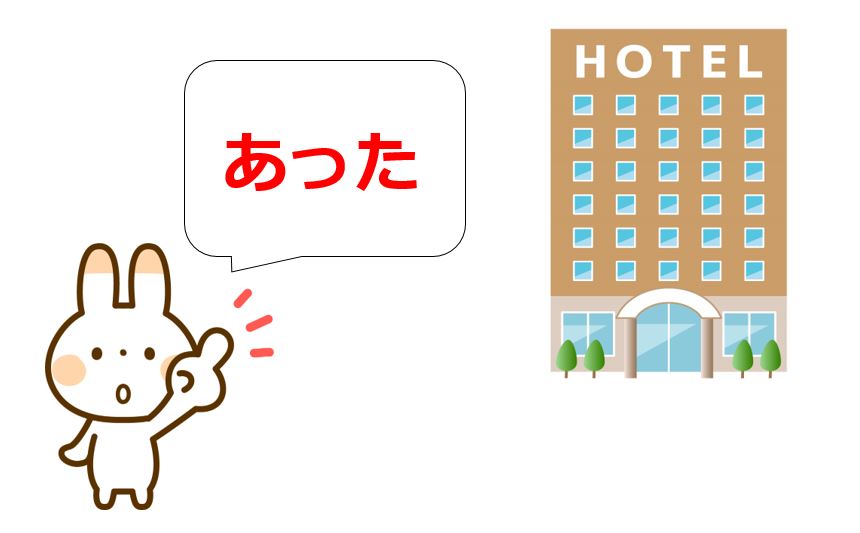Last time, you learned how the ta-form can be utilized, e.g. “着物を着た人: person who wears a kimono” and “医者だった井上さん: Inoue-san who was a doctor.” The ta-form can express not only past tense and present perfect tense, but also modify nouns as well. Here is another important function of the ta-form, which expresses discovery and recall. You will learn the usage in this lesson.
Explanation for How the Ta-form Works to Express Discovery and Recall
In order to understand the usage, you must have prior knowledge of the ta-form. If you have some doubts about how the ta-form works, please review the previous lessons before proceeding.
Discovery: ある, いる, and Adjectives
In English you can say, “I’ve found it” when you have discovered something. In Japanese, you can also say “見つけた.” As you may have noticed, the concept is same. You have applied present perfect tense for the verb “見つける: to find.” Then, there is another way to express the same thing, which is to utilize “there” like “there it is.” How could we say that in Japanese? This is the place where the ta-form comes into play.
| トイレが | あった / ありました |
| Inanimate Subject | Verb |
| There is the restroom. *Said when you are looking for a restroom. |
|
| ケンが | いた / いました |
| Animate Subject | Verb |
| There is Ken. *Said when you are looking for Ken. |
|
If you apply the ta-form for ある and いる, you can express “I’ve found it” or “there it is” in Japanese. Here, there must be some contexts, e.g. you are looking for it. You can also use this function with adjectives.
| 図書館が(あった / ありました)。 [After you’ve been looking for it] there’s the library. |
| ボブが (いた / いました)。 [After you’ve been looking for him] there’s Bob. |
| 日本は寒かった(です)。 [I’ve noticed] Japan is cold. |
| 注射は痛く(なかった / ありませんでした)。 [I’ve noticed] injections are not painful. |
If you bump into Ken by chance, you have to just say “ケンがいる (There is Ken)” because there is no prior context.
[adsense]
Discovery and Recall
| この文章は | 中国語(だった / でした) |
| Topic / Subject | Predicate |
| [I’ve noticed] this sentence is Chinese. *Said when you notice it’s Chinese after trying to read it for some time. |
|
| 今日は | 休み(だった / でした) |
| Topic / Subject | Predicate |
| [I’ve recalled] today is a day off. *Said when you recall today is actually a day off after looking at a calendar. |
|
When you apply the ta-form for nouns with the state-of being style, you can express discovery or recall, which will be determined by contexts. If there is no prior context, you cannot use this function, e.g. with the first example, if you notice it’s Chinese at first sight, you need to simply say “この文章は中国語だ (This sentence is Chinese).”
| プレゼントは指輪(だった / でした)。 [I’ve noticed] the present is a ring. |
| 田中さんは先生じゃなかった(です)。 [I’ve noticed] Tanaka-san is not a teacher. |
| Appleはアメリカの会社(だった / でした)。 [I’ve recalled] Apple is a US company. |
| 明日は日曜日じゃなかった(です)。 [I’ve recalled] tomorrow is not Sunday. |
You already learned that the explanatory のだ can express discovery for non-physical objects. The difference between the ta-form and the explanatory のだ is that you can use のだ with any verb apart from ある and いる.
| 明日、図書館に(行った / 行きました)。 => Wrong! |
| 明日、図書館に行くん(だ / です)。 [I’ve noticed] I will go to the library tomorrow. |
| 来週、出張(した / しました)。 => Wrong! |
| 来週、出張するん(だ / です)。 [I’ve noticed] I will take a business trip next week. |
How to Express Recall with Adjectives and Verbs?
We have explained so far that only nouns with the state-of-being style can express recall by using the ta-form. Actually, combinations between the explanatory のだ and the ta-form allows you to express recall with adjectives, verbs, and even nouns.
| 図書館があるん(だった / でした)。 [I’ve recalled] there is the library. |
| 日本は寒いん(だった / でした)。 [I’ve recalled] Japan is cold. |
| プレゼントは指輪なん(だった / でした)。 [I’ve recalled] the present is a ring. |
| 来週、出張するん(だった / でした)。 [I’ve recalled] I’ll take a business trip next week. |
Summary
- ある, いる, and adjectives express discovery with the ta-form.
- Nouns with the ta-form in the state-of-being style express discovery and recall.
- Verbs except for ある and いる express discovery with the explanatory のだ.
- You can express recall by combining the explanatory のだ with the ta-form.
This is the last function of the ta-form. Now you know that the ta-form can express past tense, present perfect tense, discovery and recall, and modify nouns. If you are confused by the various functions, please try to master the usage of past tense and present perfect tense. We can say that this is the base. Next, you will learn other types of present perfect tense.





